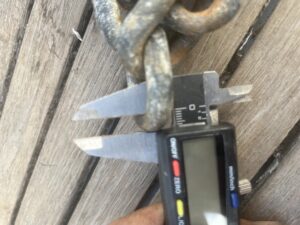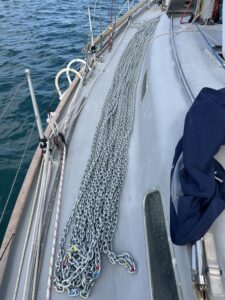
I’m still rowing.
Apparently, I’m the only one.
In the vast anchorages of the Caribbean, this is so unusual as to be considered truly eccentric.
Currently, I am in Le Marin in Martinique. I pulled in here on the way to Antigua because the Starlink only connects one time in five and if it’s the inverter that’s the trouble, I’ll have to take it back to Trinidad. Also, I’ve been trying everywhere to get an 8mm gipsy for the anchor windless. Sometimes I think cruising is nothing more than an exotic shopping expedition.
But it meant that yesterday, I made four trips between the anchorage and the dinghy dock – a total, according to my track on Navionics of more than three miles.

On my second trip – with only 50 yards to go, someone in a RIB with 15 horsepower on the back offered me a tow. I really must check my schoolboy French for: “It’s all right. If I don’t do this, I have to go to the gym.”
And it’s true. My son the doctor informs me that over the age of 60, you don’t make any more muscle – so, at 75, it’s really important to hang onto what you’ve got left.
Which, as I say, is why I am not buying an outboard after all.
I came very close to it.
Here was my problem: When I found Samsara seven years ago, it was as if the clock had spun backwards. I owned a Rival 32 in the 1980s – that was Largo. Suddenly, I could go back to the way things were. I could be 35 again!
Nobody had RIBS and davits in the 80s, so I looked up the smallest, lightest two-man dinghy – and came up with the 3D Twin-Air at just 2.3m and 13.8kg.
I knew which outboard I would put on it: The Suzuki 2hp. I could pick that up in one hand and swing myself over the guardrails and into the dinghy.
Well, that’s what I could do 40 years ago. Strange how the new one had to be laid on the side deck and then sort of shuffled into place. Also, it wasn’t really “new” at all and had acquired many of the cantankerous habits which come to us all in middle age. When it failed to start on the way home for Christmas and had I to wait for the tide the next day, I decided to give myself a present of an electric one.
Just think of it: No carburettor, no choke – no petrol. Not even any maintenance…
The little Haswing Osapian 40 weighed just 7kg (and only cost £150). Admittedly I had to add a 60ah battery which weighed as much as the Suzuki – but at least it was smaller to manhandle.
For a season, I glided silently about the anchorages of the south coast and the Channel Islands and, eventually, The Canaries.
Silently and slowly. If I wanted the battery to last any time at all, I had to limit myself to 2kts.
Well, I can row at 2kts.
Moreover, if I was rowing, I was getting some exercise. Also, I didn’t have to faff about putting it all in the dinghy and taking it all out again.
And here’s another thing: Nobody’s going to steal a dinghy without an outboard: The dinghy thieves of the Caribbean regularly abandon their purloined RIBs on the beach. The outboards, however, are never seen again.
So, I put the electric outboard on eBay and took to rowing. I might take longer to get where I’m going, but I have all the time in the world – and while I may get a bit wet going to windward in a blow, I have never yet failed to arrive.
And this was all fine and dandy – until one of the rowlocks broke.
These, I discovered, were made of plastic in moulded rubber housings glued to the tubes. Never mind, Sunny of Sunny Yacht Services in Gran Canaria made me stainless steel copies.
And all was good for another year – until, one evening in Falmouth, the moulded rubber split.
There was no fixing this – but on the other hand, the dinghy was five years old. Also, I had the wrong oars: I had lost one in Alderney and bought a new pair in Weymouth – longer and with curved blades just like the Oxford and Cambridge boats. It turned out the rowlocks weren’t designed for that kind of power.
In the end, I gave it away to someone who had an outboard and ordered a new one (promising myself that I would use only the oars which came with it.)
And everything was fine for another year – until, last week, the moulded rubber split in exactly the same place.
Was I going to buy a third new dinghy? I had written to the makers and pointed out their design flaw, but it seemed they didn’t understand the concept of rowing. Anyway, they never wrote back.
The solution was to buy yet another (and this time, heavier) dinghy. I could haul it aboard with the staysail halyard.
Or maybe I could repair the old one well enough for emergencies and get a really reliable outboard. Four-strokes are reliable – and the lightest is the Honda 2.3. But that still weighs 13kg – and that’s without the fuel and oil. Also, you mustn’t turn a 4-stroke upside down (which can happen if it weighs 13kg and there’s any chop in the harbour…)
Alternatively, there is the ePropulsion electric outboard which comes in two parts – neither of them weighing more than 11kg.
As if to compensate for this, it costs twice as much as a petrol one. Also, it has to be fed with electricity – a commodity not always available aboard Samsara.
But first, I had to manage a repair of the rowlock.
There wasn’t room to get a bolt through it. But I do have a 1½mm drill bit – and any amount of sailmaker’s thread.

Invisible mending

…and preventative measures on the other side.
I’ve tested it – all that rowing yesterday. There is no sign of the thread pulling through the rubber. In fact, I have a reel of black thread for some reason, so you wouldn’t know it’s been repaired at all. On the first trip to the dinghy dock (when I didn’t know where it was and ended up rowing 0.8 miles) it took me just 25 minutes – that’s 3kts.
And when I found the dinghy dock jam-packed with RIBs, I just pulled mine over the top of them all, upended it onto my head and went and tied it to a tree.










It’s on the way. Look forward to reading it.
Would enjoy another engagement with Jeremy Vine, so to speak.
Best Wishes
Liam
I’d love to buy it, but Amazon says not available for purchase…
Other people have been able to buy it. Please try again.
Hello John! When the book is so good as the last book I will forward to read it! Just got it! Cheers Marco
Hi John, so pleased you have brought out a new book. Sincerely hope that you will narrate an audio version soon. Looking forward to it. Nick.
Grandad always said carry a bit of string, pocket knife and a nail in your pockets. Looks like the big Of string might have been useful on your rudder.
Hello John,
I have followed your exploits with interest since newspaper days – am loving following your experiences but I don’t do Kindle !
I don’t happen to agree with carrying tons of chain especially at the end of the boat – but then I only sail coastally / cross Channel in my Anderson 22 ( 24 crossings to date but then my health put a spanner in ) have had larger cruisers but the A22 for 46 years, longest serving boat at my club in Chichester Harbour ) so speed dodging the weather is primary, have spent a few times at anchor in Studland Bay in F8-10—
In that place, sheltered from the SW’ly gales despite quite wild conditions – the strong Katabatic gusts from the hills were by far the main concern, with other boats dragging ( we set off in rescue, long story but all was fine ) I was OK with my – real, original – 7.5 kg Bruce anchor, 20′ or so of 1/4″ heavy chain, 30 m of 14mm nylon warp and a 7kg folding grapnel kedge let down the bower line in folded state as an ‘ angel ‘ to take the shock out of the waves – I know Angels aren’t fashionable any more but it worked for me.
The reason I carry a folding grapnel as kedge on holiday cruises – normally I just potter around the Solent – is apart from its’ primary role as angel, in unfolded pointy state might grab a toehold through weed onto rock, ie in emergency in a place I’d never contemplate anchoring usually !
BUT the folding grapnel relies on relatively weak hinge pins, so definitely if it held in an emergency just a case of getting one’s breath before the next plan, not an overnight stay if one could avoid it.
Hope you are well and shipshape and your accounts may be on here sometime soon – look after yourself,
Andy
The Rival 32 is a particularly good load carrier – particularly in the bow. By the way, if your health is interfering with your sailing, have a look at https://oldmansailing.com/good-health.